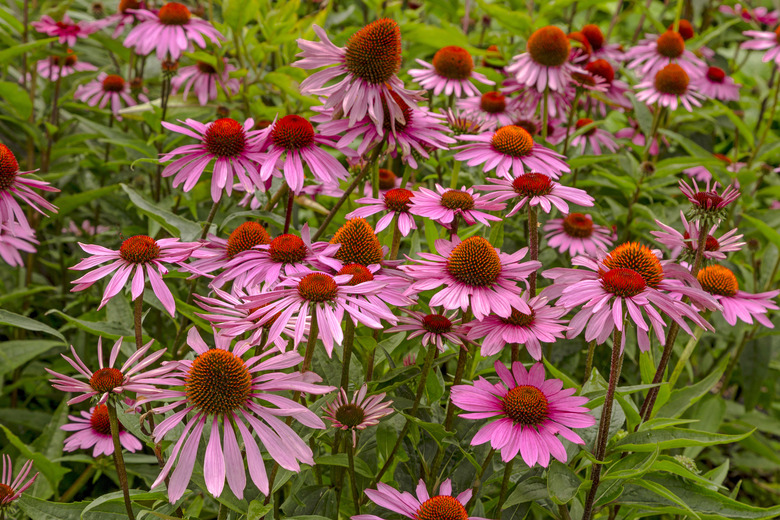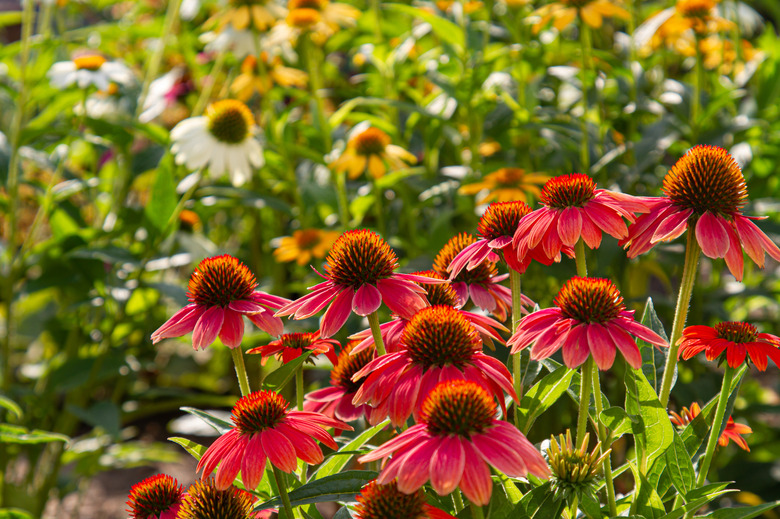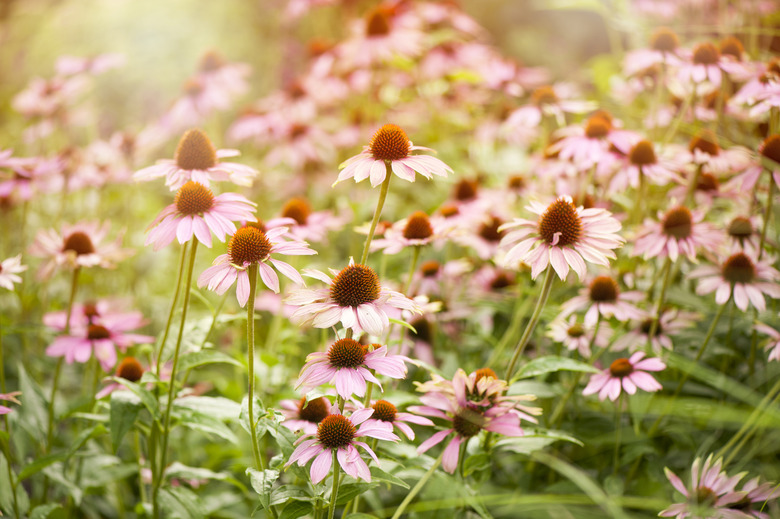How To Grow Coneflowers
We may receive a commission on purchases made from links.
- Best uses for coneflowers
- How to grow coneflowers
- In what zone do coneflowers grow best?
- When should you plant coneflowers?
- Soil, sunlight and water recommendations for coneflowers
- How to propagate coneflowers
- How to winterize coneflowers
- Common pests and other problems for coneflowers
- Common diseases for coneflowers
As United States native plants, coneflowers (Echinacea spp.) grace gardens all throughout the country. Because they are found here naturally, they are well adapted to the growing conditions American gardens have to offer. These perennial flowers are members of the sunflower family (Asteraceae) and are incredibly easy to grow, even if you fear you've been cursed with a black thumb.
Coneflowers grow about 2 to 4 feet tall and up to 2 feet wide. They flower in midsummer and keep blooming through the fall. Although purple coneflowers are the most well-known (Echinacea purpurea, USDA zones 3-8), these beauties also come in different species and cultivars with pink, red, yellow, orange and white flower heads.
Best Uses for Coneflowers
Best Uses for Coneflowers
Coneflowers work well as border plants and can put on quite a show when grown together in large patches. They're quite charming in wildflower gardens and meadows as well. Because they're native to the U.S., most gardeners find them to be very low maintenance, naturally pulling what they need from their environment.
Although they will eat anything when they're hungry enough, deer generally avoid coneflowers because of the spiky midcenters that usually deter them. Coneflowers attract bees and butterflies, who feed on the pollen and nectar, and birds, who enjoy their tasty seeds in the fall and winter. Cardinals and goldfinches are particularly attracted to the plants. Coneflowers' long stems also make them great for cut flowers.
Coneflower is the plant that herbal supplement manufacturers sell as Echinacea, and it does have medicinal uses. Some believe that Echinacea boosts the immune system and fights off the common cold, but scientists aren't quite as convinced as herbalists. You can use the flower petals and stems of Echinacea to make tea if you're a believer but never do so without first consulting your doctor.
How to Grow Coneflowers
How to Grow Coneflowers
- Common Name: Coneflower
- Botanical Name: Echinacea spp.
- When to Plant: Wait until night soil temperatures are above 65 degrees Fahrenheit
- USDA Zones: 3-10, depending on species and cultivar
- Sun Exposure: Full sun
- Soil Type: Well-draining, loamy soil
- When it's in Trouble: Droopy appearance, green nodules rather than flowers, spotted leaves
- When it's Thriving: Produces strong, upright stems topped with flowers
Starting Coneflowers From a Seedling
It's possible to grow these flowers from a coneflower seed, but the plants take two or three years to bloom. For more attractive and colorful results quickly, plant young seedlings instead of seeds. Before planting your coneflowers, work about 4 inches of compost into the top 12 to 15 inches of soil. Coneflowers are light feeders, so mixing nutrients into the soil now means you won't need to fertilize your plants later.
Dig planting holes for your coneflowers that are 1 to 3 feet apart, making each planting hole about twice as wide as a coneflower's current pot. Place the plant in the hole and backfill, making sure you cover the plant's entire root ball. Gently water your newly planted coneflowers when you're done placing them.
In What Zone Do Coneflowers Grow Best?
In What Zone Do Coneflowers Grow Best?
Most coneflowers are perennials in USDA plant hardiness zones 3 through 10, depending on species and cultivar, and are easy to grow anywhere within this range. Coneflowers are native to many parts of the U.S., so gardeners will have no trouble growing them there, especially in the Eastern region.
Coneflowers generally don't do well indoors, so enjoy them as an annual plant if you live outside zones 3 through 10. These plants don't overwinter well in colder regions and won't get the winter dormancy period they need in warmer ones.
When Should You Plant Coneflowers?
When Should You Plant Coneflowers?
Ideally, you should plant your coneflowers as early in the spring as you can. Wait until the danger of frost has passed and nighttime soil temperatures in your area reach 65 degrees Fahrenheit. You can wait and plant coneflowers in the fall but make sure they have at least six weeks to establish themselves before the first frost is expected.
Soil, Sunlight and Water Recommendations for Coneflowers
Soil, Sunlight and Water Recommendations for Coneflowers
Coneflowers are super easy to grow and care for. Simply plant them in a sunny area with loamy soil. Amend your soil with peat moss or other organic matter, such as compost or leaf mold, if it's clay or similarly heavy. After that, all you need to do is check the soil around your coneflower about every other day. If it's dry, water it. If it's still damp, skip it. Coneflowers will perform in poor soil and are heat and drought tolerant, so you can all but ignore them after planting.
If you want to ensure that your coneflowers keep blooming into the fall when other plants have faded, prune them back 1 foot when flower buds first start to appear on the plant but haven't yet opened. Plants pruned this way will bloom later in the season. Don't cut back all your plants at once, however. Stagger your pruning so you have flowers of different heights and with different bloom times.
To encourage more flowers throughout the season, deadhead your coneflowers when the blooms die. If you do, be aware that your plants won't go to seed. This means they won't sow themselves to make more flowers or provide food for birds in the winter.
When dividing other perennial flowers in the spring, skip your coneflowers. Coneflowers spread themselves through seeds, not by sending out rhizomes and new roots. Because of this, coneflowers have a single taproot that you can't easily divide into smaller pieces. They also don't take kindly to being dug up and replanted. If you want more coneflowers, simply buy more seedlings and plant them or take cuttings.
How to Propagate Coneflowers
How to Propagate Coneflowers
If left to their own devices, your coneflowers may propagate via seed in your garden. In their natural state, coneflowers readily produce seeds and drop them, propagating themselves – one of the perks of growing a a plant species that is native in your environment.
Most coneflower cultivars are sterile, but some will produce plants that don't necessarily share all the characteristics of the parent plants. So, if you plant two genetically different individual plants (not cuttings from the same plant) that are capable of doing so, your coneflowers will produce lots of seeds and will self-sow. However, if you grow species plants (including Echinacea purpurea, E. pallida, and E. paradoxa), they'll come true from seed.
If you wish to plant new coneflowers somewhere specific in the garden, want to share your plant with a friend or want to clone a certain plant, you can propagate coneflowers from root cuttings. Cut a 1- to 2-inch section of a healthy, thick root from your plant in early spring. Lightly press the root cutting in a moist rooting medium and keep moist but not soggy. Loosely cover with a plastic bag to increase the humidity. The root cutting will sprout and make a new plant.
How to Winterize Coneflowers
How to Winterize Coneflowers
Coneflowers generally die back in the fall and wait out the winter months just fine in the ground. If your garden is in zone 6 or colder, where hard freezes happen, cover your coneflower plants with about 6 inches of mulch late in the fall or early in the winter when your plants finish blooming for the season. This will give your plants a little extra insulation during the winter months.
Instead of deadheading your coneflowers before mulching over them, consider leaving the bare stems. The seed head at the center of the coneflower is where the seeds are, and many birds eat them over the winter when food is scarce. If you leave the stems and seed heads intact, birds will visit your garden and bring some cheer during the winter months. You can then cut down the stems in the spring to make room for new growth.
If you prefer, you can grow coneflowers in containers. If you do, you'll need to bring the containers indoors for the winter if your hardiness zone is two zones warmer than the coldest zone in which your coneflower plant is hardy. For example, if your potted coneflower is hardy to zone 3, you'll need to live in zone 5 or warmer to keep the container outside during winter. If you're in zones 3 or 4, you'll need to overwinter the container indoors.
Cut back the plants to the soil level and then place the container in an area where it will receive indirect sunlight. When overwintering indoors, shoot for a temperature between 40 and 50 degrees Fahrenheit. Lightly water your plants over the winter but only when the top 3 inches of soil are dry.
Common Pests and Other Problems for Coneflowers
Common Pests and Other Problems for Coneflowers
Aphids are, of course, a possibility in almost any garden on just about any plant. Coneflowers are no exception, but shooting aphids off coneflowers with water from your garden hose is usually enough to deter them.
Coneflowers can also fall victim to Japanese beetles. Although there are many traps and sprays available at your local garden center for repelling them, the best control method is often handpicking. Simply pluck the beetles off the plants by hand and drop them into a bucket of soapy water to drown them.
Upon occasion, mites, caterpillars, cutworms and root borers can infest coneflowers. When they do, an insecticidal soap will usually curb the problem.
When examining your coneflowers for pests, don't mistake the helpful soldier beetle for a problem. Usually appearing later in the season around August, soldier beetles are about 1/2 inch long and have wings that look like they're made of leather or cloth. Soldier beetles eat aphids, caterpillars and other problematic insects, so you don't want to mistake them for pests and kill them.
Common Diseases for Coneflowers
Common Diseases for Coneflowers
Coneflowers sometimes fall victim to a disease known as aster yellows. When they do, the plants sprout strangely mutated flowers that are green and horribly misshapen. These growths often resemble the hops used to make beer. If your coneflowers fall prey to aster yellows, pull them out of the garden and destroy them right away. The disease lives in the plants and not the soil, so you can replant coneflowers in the same place if you have to dispose of yours.
Besides aster yellows, coneflowers are prone to all the fungi, bacteria and rots that can affect almost any garden plant. The best way to avoid these issues is to allow room for air circulation around your plants and keep the area around them free of weeds and dead leaves. Fortunately, these diseases aren't common, and most gardeners grow coneflowers without ever encountering them. When they do occur, the best treatment is to remove infected plants and treat others with neem oil or a copper fungicide.
References
- Miracle-Gro: How to Grow Coneflowers
- WebMD: Echinacea for the Common Cold
- UCLA Health: The Echinacea Controversy: Herbal Remedy for Colds?
- Burpee: Learn About Echinacea
- Cornell University: Coneflower, Purple
- Garden Gate: Coneflower Growing Guide
- The Old Farmer's Almanac: Growing Coneflowers
- Iowa State University Extension and Outreach: Soldier Beetle
- Plant Delights Nursery: Echinacea Explosion – The Coneflower Chronicles


